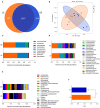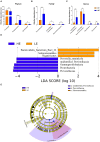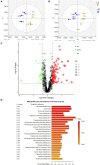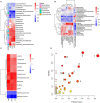Dietary Energy Level Impacts the Performance of Donkeys by Manipulating the Gut Microbiome and Metabolome
- PMID: 34692802
- PMCID: PMC8531409
- DOI: 10.3389/fvets.2021.694357
Dietary Energy Level Impacts the Performance of Donkeys by Manipulating the Gut Microbiome and Metabolome
Abstract
Considerable evidence suggests that dietary energy levels and gut microbiota are pivotal for animal health and productivity. However, little information exists about the correlations among dietary energy level, performance, and the gut microbiota and metabolome of donkeys. The objective of this study was to investigate the mechanisms by which dietary energy content dictates the growth performance by modulating the intestinal microbiome and metabolome of donkeys. Thirty-six nine-month-old male Dezhou donkeys with similar body weights were randomly assigned to two groups fed low- or high-energy diets (LE or HE). The results showed that donkeys fed HE had increased (p < 0.05) the average daily gain (ADG) and feed efficiency (G/F) compared with those that received LE diet. The gut microbiota in both groups was dominated by the phyla Firmicutes and Bacteroidetes regardless of the dietary energy level. However, feeding HE to donkeys significantly decreased (p < 0.05) the ratio of Firmicutes to Bacteroidetes (F/B). Compared to the LE group, feeding HE specifically increased the abundances of unidentified_Prevotellaceae (p = 0.02) while decreasing the richness of unidentified_Ruminococcaceae (p = 0.05). Compared to the LE group, feeding the HE diet significantly (p < 0.05) upregulated certain metabolic pathways involving the aspartate metabolism and the urea cycle. In addition, the increased bacteria and metabolites in the HE-fed group exhibited a positive correlation with improved growth performance of donkeys. Taken together, feeding the HE diet increased the richness of Prevotellaceae and upregulated growth-related metabolic pathways, which may have contributed to the ameliorated growth performance of donkeys. Thus, it is a recommendable dietary strategy to feed HE diets to fattening donkeys for superior product performance and feed efficiency.
Keywords: digestible energy; donkey; growth performance; metabolome; microbiome.
Copyright © 2021 Zhang, Zhang, Wang, Du, Zhang and Lee.
Conflict of interest statement
The authors declare that the research was conducted in the absence of any commercial or financial relationships that could be construed as a potential conflict of interest.
Figures




Similar articles
-
Cecal Microbial Diversity and Metabolome Reveal a Reduction in Growth Due to Oxidative Stress Caused by a Low-Energy Diet in Donkeys.Antioxidants (Basel). 2024 Nov 11;13(11):1377. doi: 10.3390/antiox13111377. Antioxidants (Basel). 2024. PMID: 39594519 Free PMC article.
-
Remodeling of intestinal bacterial community and metabolome of Dezhou donkey induced by corn silage.Sci Rep. 2024 Jul 24;14(1):17032. doi: 10.1038/s41598-024-67869-y. Sci Rep. 2024. PMID: 39043883 Free PMC article.
-
Diet Type Impacts Production Performance of Fattening Lambs by Manipulating the Ruminal Microbiota and Metabolome.Front Microbiol. 2022 Apr 25;13:824001. doi: 10.3389/fmicb.2022.824001. eCollection 2022. Front Microbiol. 2022. PMID: 35547127 Free PMC article.
-
Analysis of gut microbiota in chinese donkey in different regions using metagenomic sequencing.BMC Genomics. 2023 Sep 5;24(1):524. doi: 10.1186/s12864-023-09575-z. BMC Genomics. 2023. PMID: 37670231 Free PMC article.
-
The Food-gut Human Axis: The Effects of Diet on Gut Microbiota and Metabolome.Curr Med Chem. 2019;26(19):3567-3583. doi: 10.2174/0929867324666170428103848. Curr Med Chem. 2019. PMID: 28462705 Review.
Cited by
-
The Response of Ruminal Microbiota and Metabolites to Different Dietary Protein Levels in Tibetan Sheep on the Qinghai-Tibetan Plateau.Front Vet Sci. 2022 Jun 29;9:922817. doi: 10.3389/fvets.2022.922817. eCollection 2022. Front Vet Sci. 2022. PMID: 35847641 Free PMC article.
-
Could Weaning Remodel the Oral Microbiota Composition in Donkeys? An Exploratory Study.Animals (Basel). 2022 Aug 10;12(16):2024. doi: 10.3390/ani12162024. Animals (Basel). 2022. PMID: 36009615 Free PMC article.
-
Effects of dietary metabolizable energy and crude protein levels on production performance, meat quality and cecal microbiota of Taihe Silky Fowl during growing period.Poult Sci. 2025 Jan;104(1):104654. doi: 10.1016/j.psj.2024.104654. Epub 2024 Dec 8. Poult Sci. 2025. PMID: 39693962 Free PMC article.
-
Effects of Dietary Protein Levels on Production Performance, Meat Quality Traits, and Gut Microbiome of Fatting Dezhou Donkeys.Microorganisms. 2025 Jun 14;13(6):1388. doi: 10.3390/microorganisms13061388. Microorganisms. 2025. PMID: 40572280 Free PMC article.
-
The Possibility of Including Donkey Meat and Milk in the Food Chain: A Southern African Scenario.Animals (Basel). 2022 Apr 21;12(9):1073. doi: 10.3390/ani12091073. Animals (Basel). 2022. PMID: 35565500 Free PMC article. Review.
References
LinkOut - more resources
Full Text Sources

